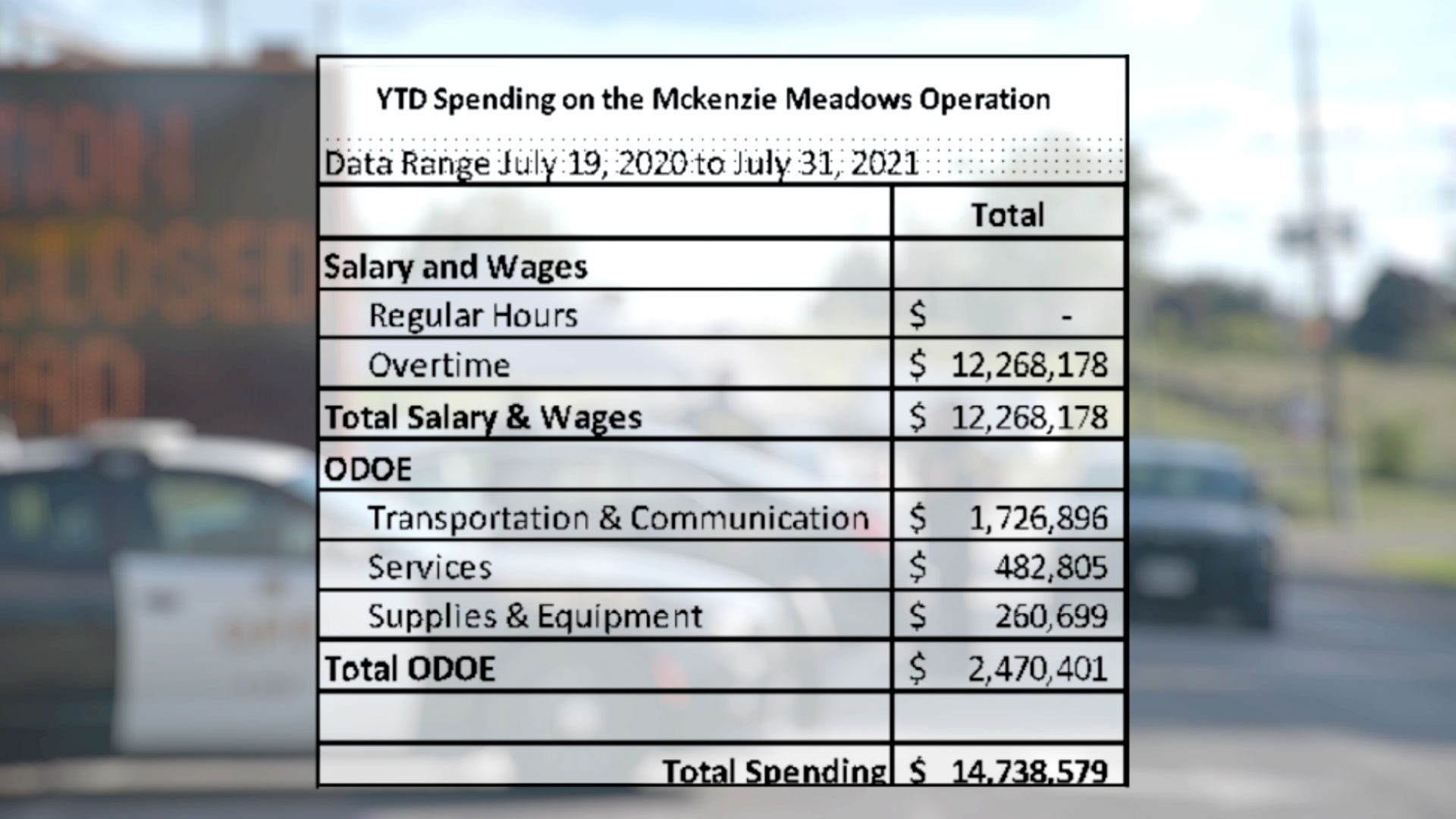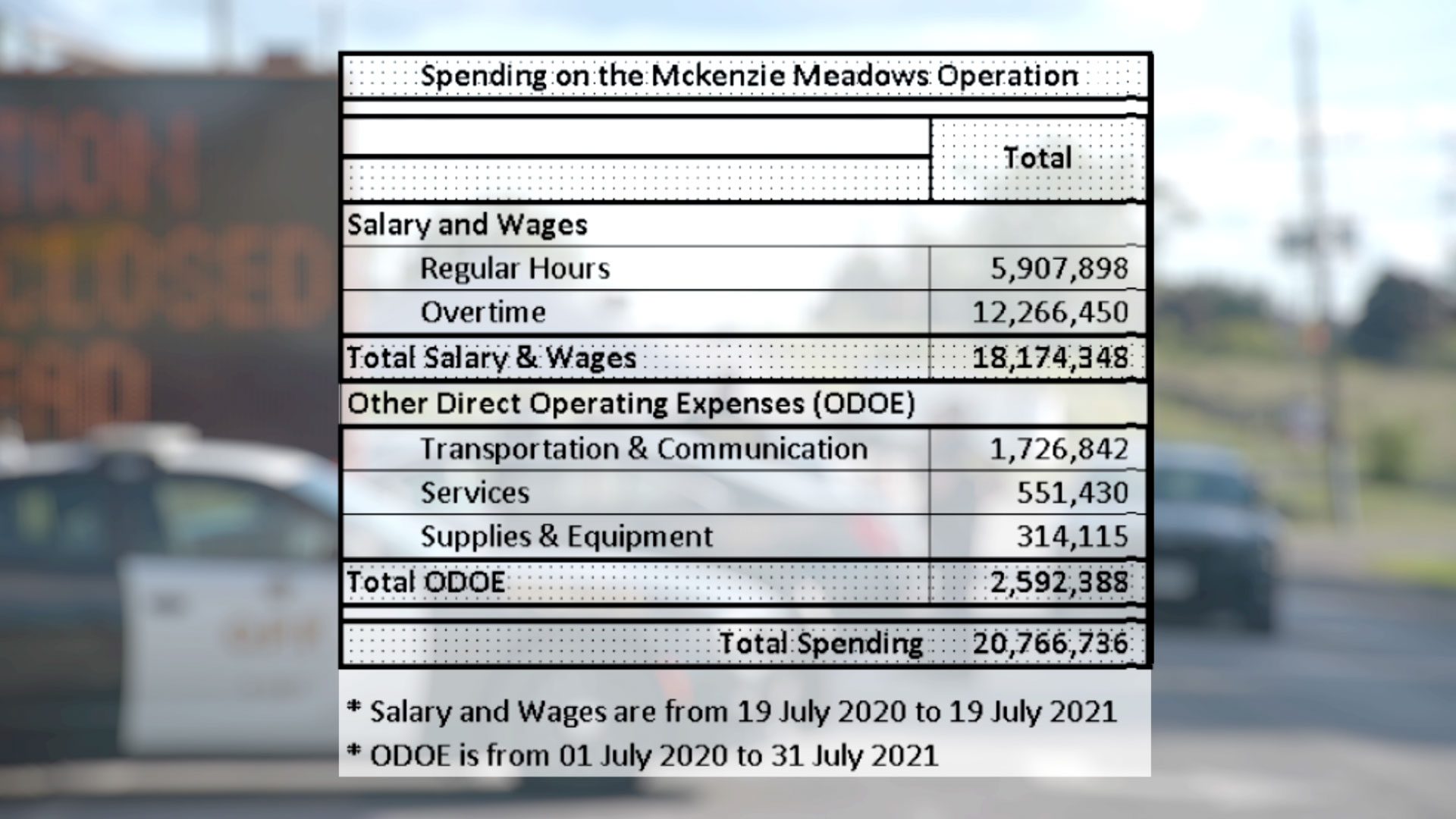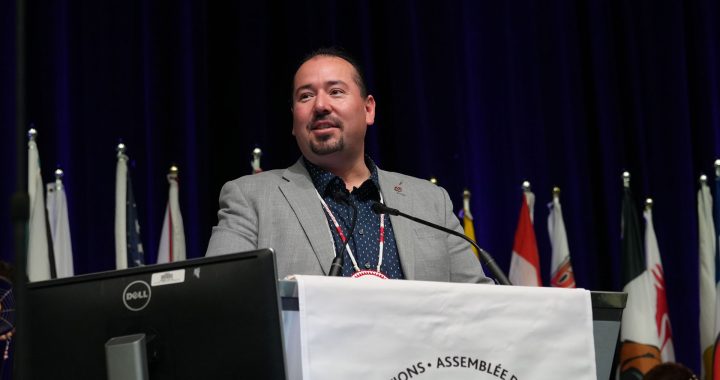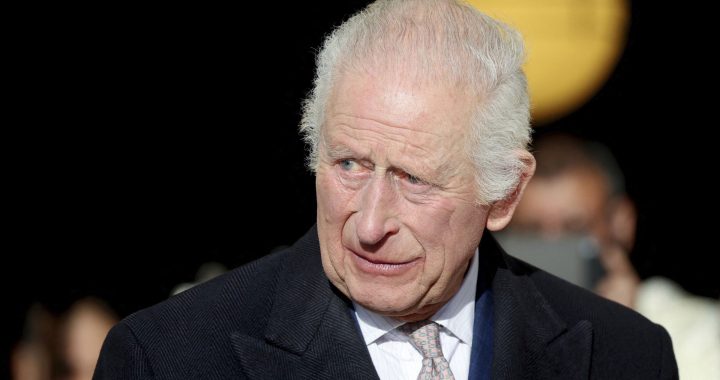Ontario Provincial Police (OPP) tried to retract already released records and alter figures to hide the real cost of the force’s operations at the 1492 Land Back Lane camp in the small town of Caledonia.
But following months of bureaucratic wrangling and an appeal to Ontario’s information commissioner, APTN News obtained an uncensored one-year spending breakdown under provincial freedom of information laws.
The newly released figures reveal police spent nearly $21 million at the disputed 25-acre McKenzie Meadows housing development, which Six Nations activists occupied in July 2020 and continue hold.
“Those numbers, they’re just so astronomical that it’s hard to even put it into context,” said Skyler Williams, spokesman for the land back group, in an interview. “It’s a far cry from what I think of when I think of reconciliation.”
The fight over this data began in March 2021 when APTN obtained an unredacted tabulation of OPP spending during the first six months of the standoff. It indicated the force spent more than $16 million.

In an accompanying letter, the Ministry of the Solicitor General’s FOI branch said it had granted “total access” to the files. APTN followed up with an identical request for a year’s worth of spending once July 2021 rolled around.
But two months later, in September 2021, the branch wrote again, this time on behalf of the OPP, saying the initial disclosure “included expenditure amounts that should not have been included.”
The Ontario government wanted to retract these previously disclosed records and instead re-release the same document, but with part of it censored.
This document suggested the OPP spent $12.3 million in six months.
Government tried to alter total
Police wanted to exclude the other $4 million not because it wasn’t spent on the operation but because that’s how much money officers redeployed to Caledonia or backfilling for their colleagues were paid in regular wages.
In other words, they get paid no matter what; it shouldn’t matter where.
“The revised amount being provided to you is an accurate calculation of costs, and aligns to the methodology in reporting costs for the OPP,” the ministry’s FOI branch claimed, maintaining the now-redacted document still constituted “total access.”
Only a week later, the ministry released APTN’s follow-up request for a year-long breakdown, but this time under its preferred accounting scheme. It claimed the force spent $14.7 million in a year.

The regular hours column was redacted, meaning the total expenditure on the bottom of the document was misrepresented. The government never offered a legal reason for retracting the files, altering the total, or deciding to censor the document.
APTN appealed to the information commissioner, arguing this amounted to a campaign of procedural obstruction and wilful opaqueness through bureaucratic maneuvering.
The regular wages column in the original unredacted table shows how much money and manpower police used to enforce two court-ordered injunctions at the site. APTN argued these figures should therefore be included as a relevant expenditure.
The commissioner’s office stepped in, and finally, six months later, the ministry released the uncensored document showing the force spent $20,766,736 on salaries, overtime, transportation, communication, supplies and other expenses like food, hotels and building rentals.

Over a year, officers working on the file earned $5.9 million in regular pay and an additional $12.3 million in overtime, amounting to $18.2 million in personnel costs.
The document shows police spent more than $2 million per month, sometimes more than $3 million per month, for seven months straight until expenditures plunged markedly in March 2021 and again the following month.
On the ground, this meant round-the-clock enforcement. Cruisers filled parking lots across the region. An incident command post was established at the local library while the detachment in nearby Cayuga got a boost.
The police manned their own blockades with a half dozen cruisers each and brought in special officers including riot squads, plainclothes liaisons, intelligence specialists, drone operators and OPP air support.
Efforts to conceal ‘almost expected now’
This huge, pricey operation fits with a countrywide pattern in which police target Indigenous activists with heavy use of force on one hand and sprawling but secretive surveillance on the other, according to Williams.
And so he said he isn’t surprised by police and government efforts to conceal the associated costs.
“At this point, it’s almost expected now,” said Williams. “We see this across every Indigenous movement that has happened to protect our lands, protect our waters: this exact same response around trying to cover up the fact that they’re watching everything.
“Everybody’s being monitored. Social medias are being monitored. There’s a lot of questions that I would like to have answered that I know are never going to be answered.”
Read more:
OPP spent more than $16M policing 1492 Land Back Lane: Records
Ottawa tracked Mohawk-Wet’suwet’en links, feared repeat of 2020 blockades
He wonders whether his family’s privacy rights were violated by police spies, for instance. He wonders whether police deliberately started the Oct. 22, 2020 skirmish outside the camp’s back entrance that prompted retaliatory blockades and destruction of infrastructure.
“Was that set up?” he asked rhetorically. “Were those cops being there part of their tactic in order to draw a response from us?”
Unlike other high-profile confrontations between the Canadian state and First Nations, the centuries-old battle over land tenure along the Grand River and its two modern flashpoints in Caledonia in 2006 and 2020 have never been comprehensively investigated.
Six Nations is the largest reserve in the country but occupies less than five per cent of the original tract granted to the Haudenosaunee Confederacy in 1784.
Community leaders argue the land was never legally ceded, but rather stolen by the Crown, which proceeded to sell off parcels then squander and embezzle the community’s trust money.

In 2006, following a similar occupation that also continues today, the province paid $30 million in policing costs, $20 million in legal settlements, and $15 million to buy out that developer.
Like Williams, Courtney Skye is left with questions about the state’s handling of the occupation and the land dispute generally. She was charged twice for allegedly being at land back lane, but the charges were dropped.
“You see them trying to hide it,” said Skye, a Six Nations member and research fellow at the Yellowhead Institute think tank. “Once you see those numbers laid out it just becomes so clear that the priorities of the Crown are wrong.
“They’re set on oppression, they’re set on using their powers to inflict violence on communities, they’re using the police to do it, and there’s no real honour of the Crown.”
She said the federal and provincial government should be held accountable for giving police, the guys with guns, a blank cheque then making them the lead agency on a centuries-old political dispute.
“It’s definitely wasted money,” she said. “That $20 million hasn’t solved the problem. It hasn’t dealt with the root cause of the issue. Of course it’s wasted when you’re not actually addressing the underlying issues.”
OPP sticks to argument
Even as the ministry at last released the figures, it kept arguing regular pay shouldn’t be included because “a member would be paid whether they were attending the event or regular patrol,” urging APTN to adopt this OPP spin on the data.
“Reporting regular hours can inflate the cost of the event, as the report captures the regular hours of the member’s deployed to the event as well as any premium hours for a member backfilling time at a home location for a deployed member, as those hours are coded to the event as well,” another letter argued.
APTN requested an interview with the OPP for this story, but the force replied by asking for it own figures back, saying, “We really need to be able to see what you are working from.”
Despite first requesting this data 10 months ago, APTN offered to provide the figures verbally during the interview so the OPP could discuss them. The force refused. In a written statement, police justified the spending by saying they couldn’t ignore illegal activity or the potential for violence.
“We follow a measured approached, as laid out in the OPP Framework for Police Preparedness for Indigenous Critical Incidents. Responses to such incidents can be very complex and volatile,” said OPP spokesperson Bill Dickson. “The OPP is required to ensure adequate and effective policing services to the communities we police across the province.
“This means we cannot simply take officers who are already on-duty and relocate them to an incident such as this. As a result, members who would otherwise by off-duty are brought in, resulting in overtime costs.”
Dickson also offered no reason for withholding information other than that the OPP would rather not report the regular wages officers earned while working on the file.
As for the situation on the ground, Williams said “this fight is by no means over.”
The builder Foxgate Developments is seeking a new injunction after Ontario’s appeal court cancelled the previous one.
Skye said she hopes people demand more from their elected officials this time around to avoid another cycle of confrontation and violence.
“We have to find another way of dealing with these issues that aren’t with police,” she said. “We need better than that because these are people’s lives.”










